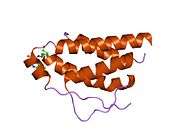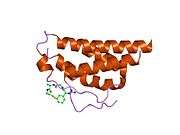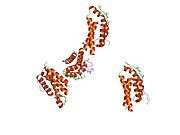Interleukin 2
| View/Edit Human | View/Edit Mouse |
Interleukin-2 (IL-2) is an interleukin, a type of cytokine signaling molecule in the immune system. It is a protein that regulates the activities of white blood cells (leukocytes, often lymphocytes) that are responsible for immunity. IL-2 is part of the body's natural response to microbial infection, and in discriminating between foreign ("non-self") and "self". IL-2 mediates its effects by binding to IL-2 receptors, which are expressed by lymphocytes.
Signaling pathway
IL-2 is a member of a cytokine family, each member of which has a four alpha helix bundle; the family also includes IL-4, IL-7, IL-9, IL-15 and IL-21. IL-2 signals through the IL-2 receptor, a complex consisting of three chains, termed alpha, beta and gamma. The gamma chain is shared by all members of this family of cytokine receptors.[4]
The IL-2 Receptor (IL-2R) α subunit has low affinity for its ligand but has the ability (when bound to the β and ϒ subunit) to increase the IL-2R affinity 100-fold. Heterodimerization of the β and ϒ subunits of IL-2R is essential for the signalling in T cells.[5]
Function
IL-2 has key roles in key functions of the immune system, tolerance and immunity, primarily via its direct effects on T cells. In the thymus, where T cells mature, it prevents autoimmune diseases by promoting the differentiation of certain immature T cells into regulatory T cells, which suppress other T cells that are otherwise primed to attack normal healthy cells in the body. IL-2 also promotes the differentiation of T cells into effector T cells and into memory T cells when the initial T cell is also stimulated by an antigen, thus helping the body fight off infections.[4] Its expression and secretion is tightly regulated and functions as part of both transient positive and negative feedback loops in mounting immune responses and dampening them down. Through its role in the development of T cell immunologic memory, which depends upon the expansion of the number and function of antigen-selected T cell clones, it also has a key role in enduring cell-mediated immunity.[4][6]
Role in disease
While the causes of itchiness are poorly understood, there is some evidence that IL-2 may be involved in itchy psoriasis.[7]
Medical use
Pharmaceutical analogues
Aldesleukin is a form of recombinant interleukin-2. It is manufactured using recombinant DNA technology and is marketed as a protein therapeutic and branded as Proleukin. It has been approved by the Food and Drug Administration (FDA) and in several European countries for the treatment of cancers (malignant melanoma, renal cell cancer) in large intermittent doses and has been extensively used in continuous doses.[8][9][10]
Interking is a recombinant IL-2 with a serine at residue 125, sold by the Hong Kong company, Shenzhen Neptunus.[11]
Dosages
There are different dosages of IL-2 across the United States and across the world being used to treat patients. The efficiency and side effects of different dosages is often a point of disagreement. Usually, in the U.S., the higher dosage option is used, depending on the cancer, response to treatment, and general health of the patient. Patients are typically given the high dosages for five consecutive days, three times a day, for fifteen minutes. The patient is given approximately 10 days to recover between treatment dosages. IL-2 is delivered intravenously for this type of dosing, and administration at hospital is generally required to enable proper monitoring of side effects.[12]
Another dosage option is in a lower regimen used by some doctors. It can be an injection of IL-2 under the skin at home or doctor’s office. It is also possible to get this dosage through an IV in the hospital over 1–3 days, similar to and often including the delivery of chemotherapy.[12]
Intralesional IL-2 is commonly used to treat in-transit melanoma metastases and has a high complete response rate.[13]
Toxicity
IL-2 has a narrow therapeutic window, and the level of dosing usually determines the severity of the side effects.[14]
Some common side effects:[12]
- flu-like symptoms (fever, headache, muscle and joint pain, fatigue)
- nausea/vomiting
- dry, itchy skin or rash
- weakness or shortness of breath
- diarrhea
- low blood pressure
- drowsiness or confusion
- loss of appetite
More serious and dangerous side effects sometimes are seen, such as capillary leak syndrome, breathing problems, serious infections, seizures, allergic reactions, heart problems or a variety of other possible complications.[12]
Intralesional IL-2 used to treat in-transit melanoma metastases is generally well-tolerated.[13]
Pharmaceutical derivative
Eisai markets a drug called denileukin diftitox (trade name Ontak), which is recombinant fusion protein of the human IL-2 ligand and the diphtheria toxin.[15] This drug binds to IL-2 receptors and introduces the diphtheria toxin into cells that express those receptors, killing the cells. In some leukemias and lymphomas, malignant cells express the IL-2 receptor, so denileukin diftitox can kill them. In 1999 Ontak was approved by the U.S. Food and Drug Administration (FDA) for treatment of Cutaneous T-cell Lymphoma (CTCL).[16]
Clinical research
IL-2 has been in clinical trials for the treatment of chronic viral infections, and as a booster (adjuvant) for vaccines. The use of large doses of IL-2 given every 6–8 weeks in HIV therapy, similar to its use in cancer therapy, was found to be ineffective in preventing progression to an AIDS diagnosis in two large clinical trials published in 2009.[17]
Discovery and development
According to an immunology textbook: "IL-2 is particularly important historically, as it is the first type I cytokine that was cloned, the first type I cytokine for which a receptor component was cloned, and was the first short-chain type I cytokine whose receptor structure was solved. Many general principles have been derived from studies of this cytokine, including its being the first cytokine demonstrated to act in a growth factor–like fashion through specific high-affinity receptors, analogous to the growth factors being studied by endocrinologists and biochemists".[18]:712
In the mid-1960s, studies reported "activities" in leukocyte conditioned media that promoted lymphocyte proliferation.[19]:16 In the mid-1970s, it was discovered that T-cells could be selectively proliferated when normal human bone marrow cells were cultured in conditioned medium obtained from phytohemagglutinin-stimulated normal human lymphocytes.[18]:712 The key factor was isolated from cultured mouse cells in 1979 and from cultured human cells in 1980.[20] The gene for human IL-2 was cloned in 1982 after an intense competition.[21]:76
Commercial activity to bring an IL-2 drug to market was intense in the 1980s and '90s. By 1983, Cetus Corporation had created a proprietary recombinant version of IL-2 (aldesleukin, later branded as Proleukin), with the alanine removed from its N-terminal and residue 125 replaced with serine.[21]:76–77[22]:201[23] Amgen later entered the field with its own proprietary, mutated, recombinant protein and Cetus and Amgen were soon competing scientifically and in the courts; Cetus won the legal battles and forced Amgen out of the field.[21]:151 By 1990 Cetus had gotten aldesleukin approved in nine European countries but in that year, the U.S. Food and Drug Administration (FDA) refused to approve Cetus' application to market IL-2.[10] The failure led to the collapse of Cetus, and in 1991 the company was sold to Chiron Corporation.[24][25] Chiron continued the development of IL-2, which was finally approved by the FDA as Proleukin for metastatic renal carcinoma in 1992.[26] By 1993 aldesleukin was the only approved version of IL-2, but Roche was also developing a proprietary, modified, recombinant IL-2 called teceleukin, with a methionine added at is N-terminal, and Glaxo was developing a version called bioleukin, with a methionine added at is N-terminal and residue 125 replaced with alanine, and dozens of clinical trials had been conducted of recombinant or purified IL-2, alone, in combination with other drugs, or using cell therapies, in which cells were taken from patients, activated with IL-2, then infused back into the patients.[23][27] Novartis acquired Chiron in 2006[28] and sold the aldesleukin business to Prometheus Laboratories in 2010.[13]
References
- ↑ "Diseases that are genetically associated with IL2 view/edit references on wikidata".
- ↑ "Human PubMed Reference:".
- ↑ "Mouse PubMed Reference:".
- 1 2 3 Liao W, Lin JX, Leonard WJ (Oct 2011). "IL-2 family cytokines: new insights into the complex roles of IL-2 as a broad regulator of T helper cell differentiation". Current Opinion in Immunology. 23 (5): 598–604. doi:10.1016/j.coi.2011.08.003. PMC 3405730
 . PMID 21889323.
. PMID 21889323. - ↑ Gaffen SL, Liu KD (Nov 2004). "Overview of interleukin-2 function, production and clinical applications". Cytokine. 28 (3): 109–23. doi:10.1016/j.cyto.2004.06.010. PMID 15473953.
- ↑ Malek TR, Castro I (Aug 2010). "Interleukin-2 receptor signaling: at the interface between tolerance and immunity". Immunity. 33 (2): 153–65. doi:10.1016/j.immuni.2010.08.004. PMC 2946796
 . PMID 20732639.
. PMID 20732639. - ↑ Reich A, Szepietowski JC (2007). "Mediators of pruritus in psoriasis". Mediators of Inflammation. 2007: 64727. doi:10.1155/2007/64727. PMC 2221678
 . PMID 18288273.
. PMID 18288273. - ↑ Noble S, Goa KL (May 1997). "Aldesleukin (recombinant interleukin-2)". BioDrugs. 7 (5): 394–422. doi:10.2165/00063030-199707050-00007. PMID 18031103.
- ↑ Bhatia S, Tykodi SS, Thompson JA (May 2009). "Treatment of metastatic melanoma: an overview". Oncology. 23 (6): 488–96. PMC 2737459
 . PMID 19544689.
. PMID 19544689. - 1 2 Pollack A (July 31, 1990). "Cetus Drug Is Blocked By F.D.A.". New York Times. This source mentions approval in 9 European countries.
- ↑ Bloombert BusinessWeek. Last updated March 3, 2014 Shenzhen Neptunus Interlng-H
- 1 2 3 4 American Cancer Society. Interleukin-2 (Aldesleukin). Date accessed: 07 Nov 10.
- 1 2 3 Shi VY, Tran K, Patel F, Leventhal J, Konia T, Fung MA, Wilken R, Garcia MS, Fitzmaurice SD, Joo J, Monjazeb AM, Burrall BA, King B, Martinez S, Christensen SD, Maverakis E. "100% Complete response rate in patients with cutaneous metastatic melanoma treated with intralesional interleukin (IL)-2, imiquimod, and topical retinoid combination therapy: Results of a case series". Journal of the American Academy Of Dermatology. 73: 645–654. doi:10.1016/j.jaad.2015.06.060.
- ↑ Shaker MA, Younes HM (Jul 2009). "Interleukin-2: evaluation of routes of administration and current delivery systems in cancer therapy". Journal of Pharmaceutical Sciences. 98 (7): 2268–98. doi:10.1002/jps.21596. PMID 19009549.
- ↑ Figgitt, DP (2000). "Denileukin diftitox.". Am J Clin Dermatol.
- ↑ FDA Page Last Updated: May 11, 2009 Changes in the Ontak (denileukin diftitiox) Package Insert to Include a Description of Ophthalmologic Adverse Events
- ↑ "IL-2 Immunotherapy Fails to Benefit HIV-Infected Individuals Already Taking Antiretrovirals". News Release. National Institutes of Health (NIH). February 10, 2009.
- 1 2 Paul WE (2008). Fundamental immunology (6th ed.). Philadelphia: Wolters Kluwer/Lippincott Williams & Wilkins. ISBN 978-0-7817-6519-0.
- ↑ Chavez AR, Buchser W, Basse PH, Liang X, Appleman LJ, Maranchie JK, Zeh H, de Vera ME, Lotze MT (Dec 2009). "Pharmacologic administration of interleukin-2". Annals of the New York Academy of Sciences. 1182: 14–27. doi:10.1111/j.1749-6632.2009.05160.x. PMID 20074271.
- ↑ Welte K, Wang CY, Mertelsmann R, Venuta S, Feldman SP, Moore MA (Aug 1982). "Purification of human interleukin 2 to apparent homogeneity and its molecular heterogeneity". The Journal of Experimental Medicine. 156 (2): 454–64. doi:10.1084/jem.156.2.454. PMC 2186775
 . PMID 6980256.
. PMID 6980256. - 1 2 3 Rabinow P (1997). Making PCR: A story of biotechnology (Paperback ed.). Chicago, IL, USA: University of Chicago Press. ISBN 978-0226701479.
- ↑ Hugo Almeida. Drugs obtained by biotechnology processing Brazilian Journal of Pharmaceutical Sciences apr/jun 2011 47(2):199-207
- 1 2 Whittington R, Faulds D (Sep 1993). "Interleukin-2. A review of its pharmacological properties and therapeutic use in patients with cancer". Drugs. 46 (3): 446–514. doi:10.2165/00003495-199346030-00009. PMID 7693434.
- ↑ "2 Biotech Pioneers To Merge". New York Times. July 23, 1991.
- ↑ Lehrman S (January 20, 1992). "Cetus: A Collision Course With Failure". The Scientist Magazine.
- ↑ Dutcher J (Nov 2002). "Current status of interleukin-2 therapy for metastatic renal cell carcinoma and metastatic melanoma". Oncology. 16 (11 Suppl 13): 4–10. PMID 12469934.
- ↑ "D02749 (Teceleukin)". KEGG drug.
- ↑ "Novartis sells rights to Proleukin in the USA to Prometheus; gets license for vaccine from IIG; and pleads guilty over Trileptal". Pharmaletter. January 27, 2010.
External links
| Wikimedia Commons has media related to Interleukin-2. |
















